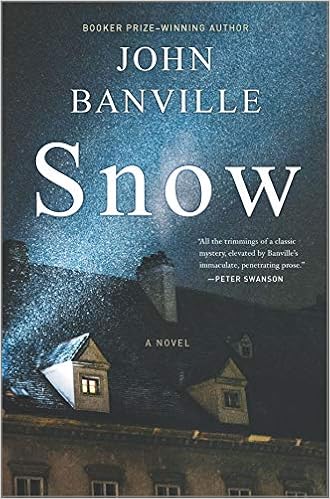4 Stars
It’s Christmas time, 1957, in the south-east of Ireland. The mutilated body of Father Tom Lawless is found in the library of Ballyglass House, the country home of the aristocratic Osborne family. Detective Inspector St. John (Sinjun) Strafford is in charge of the investigation. The Osbornes are not particularly forthcoming, and Strafford, a Protestant, also faces obstruction from the Catholic Church which publicizes the death as an accident.The mystery is easily solvable. The mutilation of the body makes the motive abundantly clear. There is some question as to the identity of the murderer, but that too soon becomes obvious. What is frustrating is that Strafford seems to ignore obvious clues and doesn’t ask why the murderer would behave in a certain way. Perhaps the explanation is that Strafford is living in a time when crime scene profiling had not yet been developed and is living in a place where certain subjects were not discussed, whereas the modern reader has knowledge of Ireland’s social and religious history.
Because the plot is so predictable, the impression is that the mystery is really a stimulus to address a larger social issue, particularly the power and influence of the Catholic Church in Ireland and its history of covering up abuse by priests. The author makes clear that he feels the church has much to answer for. Strafford is told that he must be careful: “’There’s only one Archbishop – only one that counts, at any rate. Dirty your bib and he’ll be down on you like a ton of bricks, whether you’re Catholic, Protestant, Gentile or Jew. Runs a tight outfit, does His Grace, without regard for creed, race or colour – no matter who you are, you’re still liable to get it in the neck. . . . the reverend Doctor only has to lift his little finger and your career goes up in smoke – or into the flames of hellfire, and then up in smoke. And it doesn’t just apply to priests. Anyone who gets a belt of the crozier is done for.’” A young woman tells Strafford much the same: “’A girl has to keep tabs on the likes of His Holiness John Charles, that’s for sure. I don’t want to end up a slave in a laundry somewhere, working my hands to the bone and the nuns shouting at me.’”
The opening sentence of the book suggests the power priests had; Father Tom, as he is attacked, thinks, “I’m a priest, for Christ’s sake – how can this be happening to me?” Later when Strafford asks about why priests are not reported for abuse, he is told: “’Report him to who? Maybe you haven’t heard – you don’t ‘report’ a priest. The clergy are untouchable. . . . The most that could have been done . . . would have been to get him transferred. That’s all the Church ever does, when one of theirs lands in trouble. Then he’d just get up to his old tricks somewhere else.’”
Snow becomes another obstacle Strafford has to overcome. The oppressiveness of the snow serves as a metaphor for the Catholic Church’s oppressive hold on Ireland. Travel becomes difficult in the countryside because of snowfall, just as the murder investigation is complicated by the archbishop’s interference. The snow blankets the country just as the church tries to cover up the circumstances of a priest’s death. At one point, the snow falls “in big flabby flakes the size of Communion wafers.” When Strafford quotes the last paragraph of James Joyce’s “The Dead” (“’Snow is general all over Ireland’”), he can be commenting on the church’s strong grip over the entire country.
Later in the novel there’s an Interlude written from the point of view of a sexual abuser. Reading this section is very disturbing. The man justifies his actions with comments like “[The boy] needed to be loved, whether he knew it or not” and “must have had some sense of pride at having been picked out and made my special one. That must have been a source of pleasure for him.” He addresses those who might accuse him: “Don’t tell me you know about a thing until you’ve done it. And don’t tell me that, having done it, you won’t want to do it again. Don’t point your finger at me and call me names and say that God will punish me. So few of us know what it’s like – more than you’d think, but few, all the same – we who live in the secret, enchanted world.”
It is known that people who were sexually abused in childhood often become abusive themselves. This is the pattern suggested in the novel. This fact means that the reader may feel some sympathy for a person. Since the church did nothing to help abusing priests, the cycle continued. Of course the cyclical nature of abuse also means that the information given about a victim at the end is downright chilling.
Banville’s writing impresses. Much of the language is lyrical. The description of the archbishop is perfect: there is repeated reference to his little dark eyes and his sharp, cold little smile. Telling details suggest his personality: “the tips of his [red velvet] slippers . . . appeared alternately, like crimson tongue-tips, from under the hem of his cassock. He stopped before the fire and held out his hands, which were as pale as cuttlefish bones. . . . flames gave a lurid tinge to his thin, pallid face.” Some of the diction like etiolated and brumous and boreen may have readers consulting a dictionary.
It could be argued that Banville doesn’t reveal anything that most readers don’t already know. What is unique is his using a police procedural as social commentary. The language makes the book a joy to read but the content will discomfit.
Note: I received a digital galley from the publisher via NetGalley.

No comments:
Post a Comment